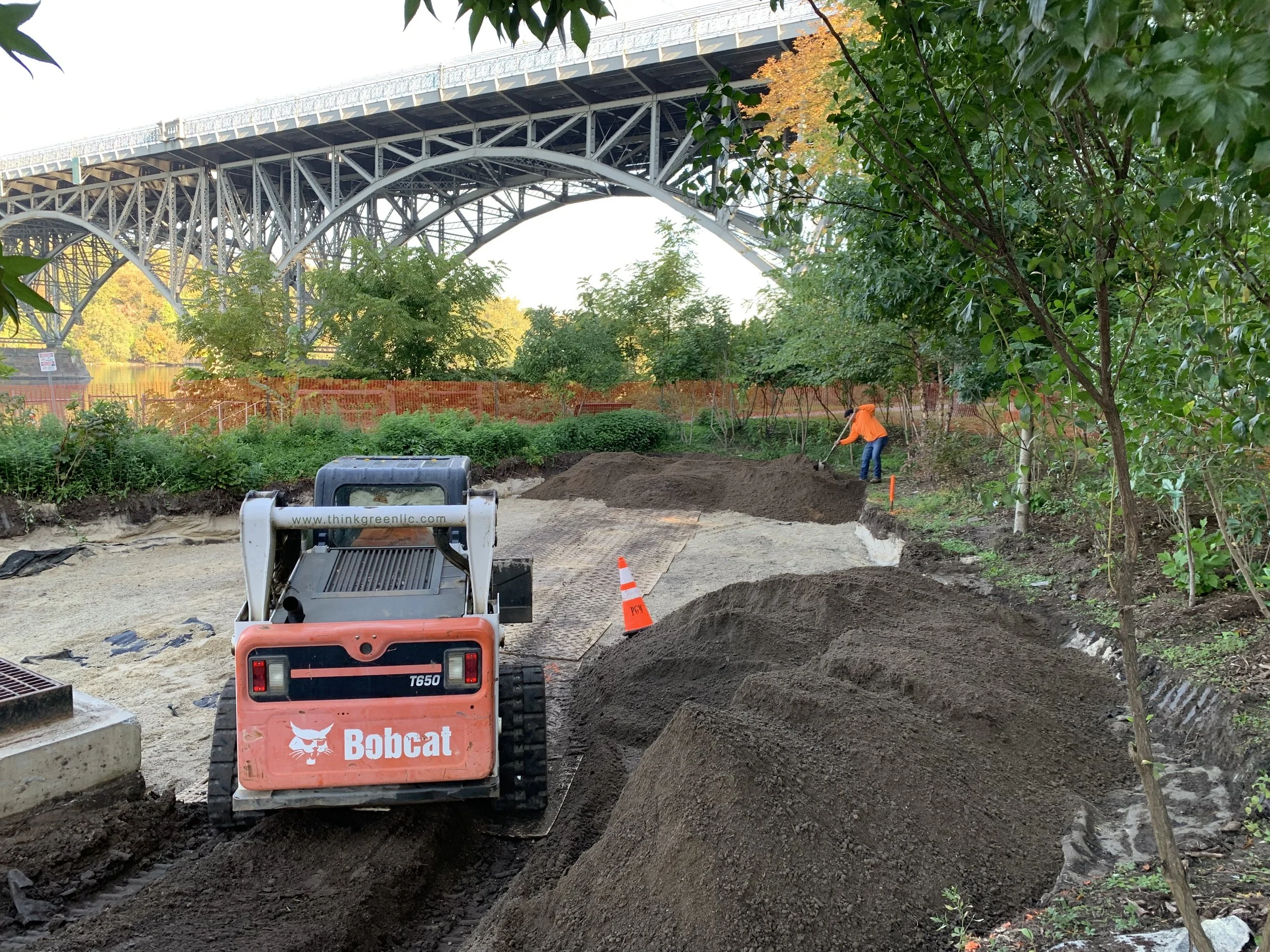Circular Soil
Can an engineered soil made of locally-sourced recycled materials support healthy plants and functional green infrastructure in urban environments?
Through the Circular Soil initiative, OLIN Labs developed and tested a locally-produced waste-based soil that simultaneously reduces reliance on environmentally damaging materials and provides a sustainable outlet for major waste streams.
Credit: OLIN / Sahar Coston-Hardy
Overview
While landscape architects have become increasingly concerned with the lifecycle costs of our projects, landscape architecture practices continue to struggle to address aspects of our work that are fundamentally extractive and wasteful. Nowhere is this more evident than in the manufacturing of engineered soils from natural components (sand, mined topsoil, peat, etc.) for use in cities.
To address this problem, the Circular Soil Initiative aims to develop high-quality green stormwater infrastructure (GSI) soils for the urban forest and parks of Philadelphia and the Delaware Valley using locally recycled glass-sand and food-waste compost. The Initiative aims to preserve the region’s natural areas, reduce waste, and support urban GSI implementation by producing a waste-based urban soil blend optimized for water quality, infiltration and plant health.
Across the U.S., the two heaviest urban waste streams (glass and food) make up the majority of landfill volume. Meanwhile, municipalities procure thousands of tons of natural sand annually for public works. Credit: OLIN
A closed-loop circular economy will transform urban waste into green infrastructure, saving the city money, reducing lifecycle costs, and creating green jobs. Credit: OLIN
Since 2017, the Circular Soil Initiative has tested how to replace mined natural sand with recycled sand made from crushed glass in GSI media. Large quantities of sand are typically a critical component of engineered soil blends used in green stormwater infrastructure systems. Sand and aggregate make up the most heavily extracted material group on the planet, above even biomass and fossil fuels. In many parts of the world, construction-grade sand is running out, and in the eastern US, Coastal Plain sand extraction disrupts sensitive ecosystems.
Meanwhile, glass recycling in the U.S. is in a state of crisis. While glass is theoretically highly recyclable, in practice, most cities don’t have the technical capacity to clean and sort mixed color glass from single stream collection, nor do they have market outlets for glass cullet. For these reasons, the vast majority of waste glass in the U.S., including close to 100% of the glass collected through single-stream recycling in Philadelphia is sent to the landfill as “non-recyclable residue.” In Philadelphia alone, this means that over 90,000 tons of glass is disposed of annually at a cost of approximately $140/ton to the city and its residents and businesses. Modifying engineered soil mixes to include pulverized glass rather than mined sand could simultaneously reduce the reliance on environmentally damaging materials and provide a sustainable outlet for what is currently a major waste stream.
Credit: OLIN / You Wu
OLIN Labs has collaborated with universities, Philadelphia city agencies, circular economy nonprofits, soil scientists, green stormwater infrastructure experts, and companies engaged in glass recycling, composting, and soil blending to test and pilot a range or soil blends.
Across three funded phases, the team pursued two research tracks: (1) developing a manufacturing process and material specification for a glass-based soil blend (GBS) that contains recycled glass-sand and food waste compost; and (2) technical and commercial planning to develop economically feasible systems for manufacturing and utilizing the proposed GBS blend locally.
In Philadelphia, the project successfully connected a constellation of local small businesses, nonprofits and municipal partners, working to create a local closed loop economy for glass and food waste, thus contributing to the city’s ecological and economic sustainability and resilience. Going forward, this applied research is openly shared with municipalities across the country, to move the needle on domestic recycling and life cycle cost reduction in the built environment.
Early research phases, including a Life Cycle Assessment, a laboratory-based mesocosm study, and two greenhouse trials set the stage for a year-long field trial, completed in 2023, which monitored the horticulatural and hydraulic performance of an experimental bioretention garden. This pilot project, funded by the US EPA and in partnership with Philadelphia’s Department of Parks and Recreation, demonstrated the long-term horticultural and hydraulic viability of Circular Soil (CS). Results indicate that the waste-based soil did not adversely impact the water quality or water quantity performance of the bioretention system. Minor decreases in plant height are noted, while vegetative cover is similar across soil treatments. Exchangeable metal concentrations fall below drinking water limits. Commercialization analysis demonstrates that CS can compete with conventional sand-based topsoil and that a bona fide market for CS exists.
For further details, see the US EPA SBIR Phase II Study Executive Summary and Final Report.
Related Press
Schuler, Timothy A. (2019, September). “The Glass is Greener: Can waste glass be repurposed as a planting medium for green infrastructure?”, Landscape Architecture Magazine.
Philanthropy Network. (2019, December). “William Penn Foundation announces new grants”, https://philanthropynetwork.org/news/william-penn-foundation-announces-new-grants
EPA Press Office. (2022, January). “EPA Awards More Than $3 Million in Funding to U.S. Small Businesses to Commercialize Environmental Technologies”, https://www.epa.gov/newsreleases/epa-awards-more-3-million-funding-us-small-businesses-commercialize-environmental
ASLA. (2022). “2022 ASLA Professional Awards: Soilless Soils: Investigation of Recycled Color-Mixed Glass in Engineered Soils”, https://www.asla.org/2022awards/5903.html?s=15
Soil-less Soil Study - A Sustainable Solution for Green Infrastructure Soil Media - Part 1, Life Cycle Assessment. https://repository.upenn.edu/entities/publication/d43d4f1b-1db7-47f0-9438-1489b7fd80f9
Funding Sources
The William Penn Foundation
The United States Environmental Protection Agency













